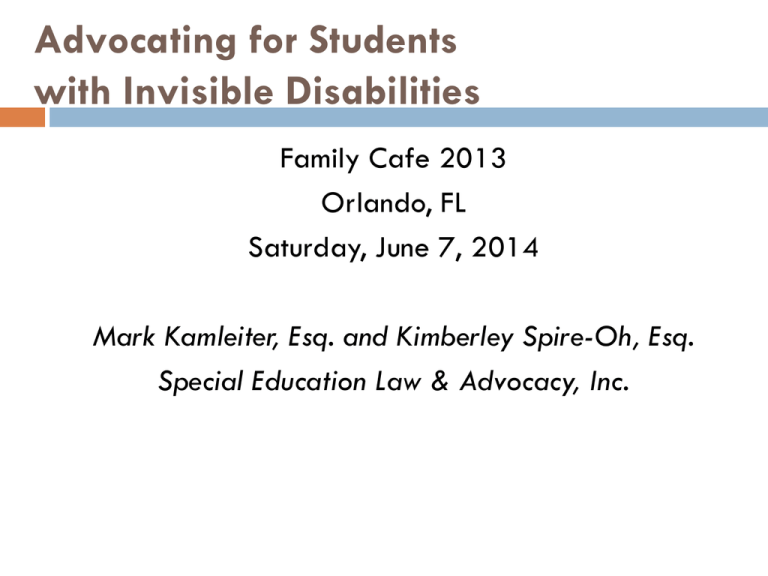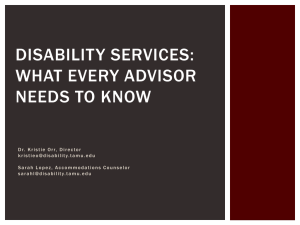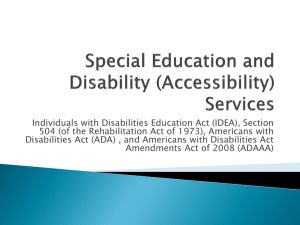Advocating for Students with Invisible Disabilities
advertisement

Advocating for Students with Invisible Disabilities Family Cafe 2013 Orlando, FL Saturday, June 7, 2014 Mark Kamleiter, Esq. and Kimberley Spire-Oh, Esq. Special Education Law & Advocacy, Inc. What Do We Mean by “Invisible” Disabilities? Many students who have learning differences that adversely affect their education face barriers to getting the support they need in school. Why? Factors that obscure a student’s disability Good grades or test scores; Teachers think it is “lack of motivation,” “laziness,” or “willful refusal;” They do not cause a disruption, so their struggles go unnoticed; Inappropriate evaluation tools underestimate their true ability; or They or their families overcompensate for the disability with private tutoring or spending six hours a night on homework. Examples of “Invisible Disabilities” Attention Deficit/Hyperactivity Disorder (ADHD) Asperger’s/High-Functioning Autism Some forms of Epilepsy Mental Health Conditions (i.e., Anxiety, Reactive Attachment Disorder) Dyslexia/Dysgraphia Gifted students with additional exceptionalities Sensory Processing/Integration Disorders Auditory and Visual Processing Disorders Anxiety, OCD, trichotillomania Possible Reasons for Refusing Services and Accommodations Misunderstanding the genesis of the problem: Far too often, educators view the disability as a “behavior,” in the sense that the child is in control of the problem and can just stop doing it – if he/she wanted to. The child is considered lazy, unmotivated, or rebellious. The child is just not “paying attention.” The child talks back, or is oppositional. The child simply refuses to stay in his/her seat or area. All of these “behaviors” may well be indicators of an underlying disability. Possible Reasons for Refusing Services and Accommodations Failure to believe in the disability: Some educators do not believe in Bipolar Disorder or ADHD. These are real, medically-documented disorders and they can have a significant impact upon a child’s education. We must educate our educational professionals better. It may be due to the fact that the public, including doctors, are increasing their understanding of these disabilities, that the number of children diagnosed with disabilities is rising. Possible Reasons for Refusing Services and Accommodations Resistance to perceived fraud: Some parents (and advocates) may attempt to obtain ESE eligibility for improper “non-educational” reasons (Obtaining SSI, improper advantage on high-stakes testing, obtaining McKay scholarships for non-disabled children). However, the school district’s obligation is to focus on one issue: Does the child have an educational disability? Possible Reasons for Refusing Services and Accommodations Failure to understand the legal eligibility thresholds: Many educators are woefully ignorant of the legal requirements for eligibility of students with “unidentified disabilities.” This is particularly true where the children are making passing or even good grades. Possible Reasons for Refusing Services and Accommodations Although the law has always included these children, in 1997 the IDEA was amended to make it clear that Congress intended children whose disability interfered with their interaction with their environment. They specifically mentioned ADHD so as to quiet some of the controversy as to whether ADHD and related disorders were eligible for IDEA services. Solutions Improve our procedures for identifying students with disabilities. Perform evaluations whenever a student is suspected of having a disability, as required by law; Remain faithful to the requirements for the identification of students with disabilities, as provided under the IDEA and Section 504. Solutions Provide better training to school staff (and private providers) who are engaged in identifying students with disabilities and making eligibility decisions for 504 plans and IEPs. In fact, this training should be provided to all teachers, as general education teachers are the front line to identifying students who are struggling in their classes and ensuring they get referred for evaluation. Sticking Points IDEA (20 USC § 1401(3) (ii): This clause adds, as a condition of eligibility, the concept that not only must a student meet one of the IDEA disability categories, but that student must, “by reason thereof, need(s) special education and related services (see statute below).” 20 USC § 1401 - Definitions (3) Child with a disability (A) In general The term “child with a disability” means a child— (i) with intellectual disabilities, hearing impairments (including deafness), speech or language impairments, visual impairments (including blindness), serious emotional disturbance (referred to in this chapter as “emotional disturbance”), orthopedic impairments, autism, traumatic brain injury, other health impairments, or specific learning disabilities; and (ii) who, by reason thereof, needs special education and related services. However… Education includes communication and language, auditory processing, behavior and social/emotional status, ability to attend, organization, physical performance, impulse control, to name just a few areas of human functioning. As children pass through our schools we take on responsibility for their success, whether it is in mathematics or in self-organization. We assume the responsibility to provide our students with the knowledge and skills necessary for their future success and independence, nothing less. A child must, by reason of his disability, require special education For a long time schools have denied eligibility when a child did not meet the numerical requirements for a learning disability. Now they have begun refusing eligibility even where a child might meet the necessary discrepancy between intellectual level and achievement. Schools argue that the child must “require” special education and will often deny special education services where a child receives a passing grade. This is growing problem for children with SLD, ADHD, or emotional disabilities. It is important for advocates to hold the line on this issue. It is important to argue that “education” includes more than academic performance. It also includes social, emotional and behavioral progress. A child may need special education even if the child is successful academically, where the child has social, emotional or behavioral issues. Furthermore, academic success is not only a question of advancing from grade to grade or “doing as well as the others in the class.” Failing grades are not necessary to qualify. 34 C.F.R. § 300.121 (e) Schools are regularly advancing students, who cannot read appropriately or perform essential math skills. It is important to insist that student progress be measured using nationally normed evaluations and not subjective teacher measures. Florida Law Helps Address This Issue F.A.C. 6A-6.030152(4)(a) states that beyond evidence of the disability, the criteria for ESE eligibility requires “evidence of another health impairment that results in reduced efficiency in schoolwork and adversely affects the student’s performance in the educational environment.” For example… 1. “Reduced efficiency in school work” – This not necessarily mean only academics. Problems with organization and auditory processing delays, for example, will certainly reduce efficiency in school work. 2. “Adversely affects the student’s performance in the education environment” - This also does not necessarily mean only academics. A student’s performance in the “educational environment” can include the student’s social/emotional, behavioral interactions, as well as a number of other student issues or disorders. The Florida Department of Education, through its Exceptional Student Education Compliance Manual, has attempted to clarify even further the requirement in Rule 6A-6.030152(4) (a). This Compliance Manual requires documented evidence of a health impairment that adversely affects the student’s performance in the educational environment. Consideration of Non-academic and academic levels of performance Seeing the continued problem, OSEP tried to bring more clarity. In the Letter to Lybarger, OSEP makes it clear that in considering the impact of a disability upon educational performance, it is essential the determination be made on an individual basis and must include examinations of both non-academic and academic areas. Furthermore, it notes that educational performance means more than “academic standards as determined by standardize measures.” In the Letter to Fenton, OSEP further clarifies this position with regard to an eligibility determination. Significance of these OSEP decisions These OSEP positions are very helpful. For the first time, we have an opinion that those making eligibility decisions must do two things: 1. First, the decision must be made on an individual basis. This is an important point and places school districts, which make sweeping determinations based upon academic performance, in danger of charges of “pre-determination.” 2. Secondly, in making the eligibility decision, one must consider both “non-academic,” as well as “academic,” performance. The Rowley Case An older Supreme Court case, the Rowley case, noted in finding that a deaf child had not suffered due to the district’s refusal to provide an individual interpreter. The Court noted that the child had not suffered academically, and not socially or emotionally either. This dictum demonstrates that the Court considers more than just academics in deciding student needs. Factors such as social and emotional status are equally important. Mr. and Mrs. I v. Maine School Administrative District 55 The federal case that probably speaks most clearly to the issues being discussed here, is a Maine case, Mr. and Mrs. I v. Maine School Administrative District 55 (Maine District, January, 2006). This case involved a young student with Asperger’s Syndrome and “depressive disorder. While she generally did well academically, she demonstrated developing social and communication issues in Grades 4 and 5. She made a serious suicide attempt when 11 and beginning the 6th grade. The parents then asked for services under IDEA, but the district refused, offering § 504 accommodations instead. The federal court judge found that “educational performance” was defined too narrowly by the school district and that the student’s disability negaitvely impacted her “educational performance.” The decision stated, “…the purpose of education is not merely the acquisition of academic knowledge but also the cultivation of skills and behaviors needed to succeed generally in life.” Florida Cases Florida has its own similar due process case, which was decided in favor of the student being a “child with a disability” in both administrative due process and then again in the federal district court, where the school district attempted to overturn the decision. This case, T.D.-F., vs. Manatee County School Board, Case No. 04-0257E (June, 2004) and Manatee County School Board vs. T.D.-F., (Middle District – Florida, September, 2005), clearly follows the same logic and comes to the same holding as the Maine court. Letter to Clark OSEP’s Letter to Clark (2007) also warns against using purely academic criteria or measures for determination of disability. It notes that: [I]n conducting an evaluation, the public agency must use a variety of assessment tools and strategies to gather relevant functional, developmental, and academic information. Therefore, IDEA and the regulations clearly establish that the determination about whether a child is a child with a disability is not limited to information about the child’s academic performance. Furthermore, 34 CFR 300.101(c) states that each State must ensure that a free appropriate public education (FAPE) is available to any individual child with a disability who needs special education and related services, even though the child has not failed or been retained in a course or grade, and is advancing from grade to grade. Variety of Assessment Tools and Strategies While grades are a factor, they cannot be the sole factor. Grades by themselves often do not faithfully indicate a child’s true academic performance. Very often an academic grade is composed of a lot of different factors (participation, effort, extra credit, etc.) and it is thus not a true indicator of the child’s academic performance in that domain. Variety of Assessment Tools and Strategies Standardized Measures are a factor. Given the comments above, it seems obvious that nationallynormed, standardized academic measures are a factor to consider. They may be an indication of a child’s true academic levels, although some caution is advised, since some children perform poorly on this kind of assessment. Variety of Assessment Tools and Strategies Are assessments such as FCAT, PSAT, etc. a valid consideration? This is an issue with us. We find that often school district’s use or refuse to use these assessments depending upon what they say about a possible disability. Our feeling that these results may be a factor to consider, but they were not designed to identify disabilities, and they must be looked at with great caution. Variety of Assessment Tools and Strategies Student work product may be a factor. Certainly, it could show the student’s ability to perform academically and functionally. The key would be found in how scientifically valid the work product sampling has been. We have seen “selective” sampling, which leaves out product that does not show what the teacher wants to show. Such sampling does nothing to develop trust and confidence. The work product examined should not be focused entirely on academic, but should also look at (depending upon the disability issues) the child’s executive functioning skills. Variety of Assessment Tools and Strategies Assessment of a student’s executive functioning, communication, social, emotional, and behavioral status as a factor. Where appropriate, the child’s gross and fine motor abilities may be a factor, as might hearing and vision. Again, these assessments should be scientific, data-driven, and varied. Some of the assessments may be normed checklists, formal assessments, observations (with empirical data), work product, etc. Variety of Assessment Tools and Strategies Parent data, evaluations, and private professional input. Too often parent data collection and private psychological, behavioral, and therapeutic evaluations and assessments are considered something to glance at and then set aside. This information needs to be incorporated into the whole of the assessment consideration of the child. If there are conflicts between the parent’s private information and the school’s information, then an effort to reconcile the information is essential. Sometimes getting a neutral third evaluation is necessary. De Facto Accommodation and Remediation In the Manatee County case discussed previously, the Judge found that the school was providing the student with a de facto IEP. In other words, the school was, in the end, providing the child with his educational needs, but doing so in such a way as to deprive the child of his legal right to an IEP. The whole educational scheme under IDEA is designed to afford children with disabilities the full protections and privileges of the Act. This can only be done when the child is brought under the umbrella of the Act through eligibility and the drafting of an IEP. Providing specially-designed instruction and accommodations, without the legal recognition of eligibility and the protections it affords, violates the child’s rights. Some helpful resources Many of the case decisions and OSEP letters referenced in our presentation can be found at http://www.kamleiterlaw.com/IEPs_Good_Grades.ht ml If you have additional questions about this topic, feel free to contact us: Mark S. Kamleiter, Esq. and Kimberley Spire-Oh, Esq. Special Education Law & Advocacy 2509 First Avenue S. St. Petersburg, FL 33712 Phone: (727) 323-2555 Fax: (727) 323-2599 info@flspedlaw.com







